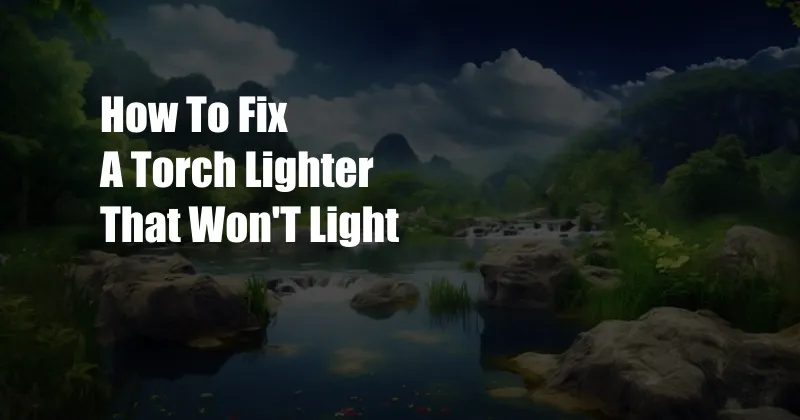
Torch Lighter Troubleshooting: Reignite the Flame
Igniting a barbecue, lighting candles, or simply navigating in the dark—torch lighters play a crucial role in our daily lives. However, when they refuse to light, it can be frustrating and inconvenient.
Fear not, torch lighter troubleshooter! In this comprehensive guide, we will delve into the intricacies of torch lighters and empower you with the knowledge and skills to restore their fiery spirit. Buckle up for an illuminating journey that will have you sparking up your torch lighter in no time.
Understanding Your Torch Lighter
A torch lighter, also known as a butane lighter, owes its fiery prowess to a combination of butane gas and a spark generated by a piezoelectric crystal. Butane gas is a highly flammable hydrocarbon that vaporizes under pressure, creating the fuel for the flame. The piezoelectric crystal, when struck, produces a jolt of electricity that ignites the butane.
Torch lighters vary in design and features, but they share a common principle: a fuel tank filled with butane and an ignition mechanism. Some models feature adjustable flames, providing precise control over the intensity and size of the flame, while others offer multiple ignition points for added convenience.
Troubleshooting Common Torch Lighter Problems
Diagnosis: Torch Lighter Not Lighting
If your torch lighter fails to light, here are the most common culprits:
- Empty or Low Butane Tank: Butane is the lifeblood of a torch lighter. Check the fuel level through the transparent window on the side of the lighter. If it’s empty or low, a refill is in order.
- Clogged Nozzle: Over time, debris and dust can accumulate in the nozzle, obstructing the flow of butane and preventing ignition. Look for any visible buildup and gently clean the nozzle with a fine wire or compressed air.
- Faulty Ignition Mechanism: The piezoelectric crystal, responsible for generating the spark, can malfunction over time. Try striking the ignition switch multiple times to see if it sparks. If not, a replacement may be necessary.
Addressing Torch Lighter Sparking But Not Lighting
Encountering sparks but no flame? Here’s what to investigate:
- Improper Butane Fill: Ensure the lighter is filled correctly with butane. If the tank is overfilled or filled upside down, it can trap air bubbles that disrupt the gas flow.
- Excessive Air Pressure: After refilling, allow the lighter to sit for a few minutes to equalize the air pressure inside. Excessive air pressure can hinder the proper vaporization of butane.
- Blocked Air Intake: The air intake holes on the side of the lighter must be clear to facilitate combustion. Inspect them for any obstructions and clear them out gently.
Expert Tips for Torch Lighter Maintenance
To keep your torch lighter burning brightly, heed these expert tips:
- Regular Cleaning: Periodically remove the nozzle and clean it with compressed air or a soft brush to prevent clogging.
- Avoid Overfilling: When refilling, fill the lighter to the indicated line or until butane starts to escape, indicating the tank is full.
- Bleed Air Bubbles: After refilling, hold the lighter upside down and press the ignition button for a few seconds to release any trapped air bubbles.
- Store Safely: Keep your torch lighter in a cool, dry place away from direct sunlight and extreme temperatures.
FAQ: Torch Lighter Troubleshooting
- Q: Why is my torch lighter leaking butane?
A: Overfilling or refilling the lighter upside down can trap air bubbles, causing excess butane to leak out. - Q: Can I use regular lighter fluid in a torch lighter?
A: No, torch lighters require purified butane fuel specifically designed for their high-pressure systems. - Q: How do I adjust the flame size on my torch lighter?
A: Look for a small screw or knob at the base of the lighter. Turn it clockwise to increase the flame size and counterclockwise to decrease it. - Q: What’s the best way to dispose of an empty torch lighter?
A: Empty the remaining butane gas outdoors in a well-ventilated area, then discard the lighter in a recycling bin designated for small electronics.
Conclusion
With the knowledge and techniques outlined in this guide, you are now equipped to fix your torch lighter and reignite the flame. Remember, regular maintenance and proper handling will extend the life of your torch lighter, ensuring it remains a reliable companion for all your lighting needs.
Share your success stories or lingering questions in the comments below. Your fellow torch lighter enthusiasts are eager to connect and support you in your lighting adventures.